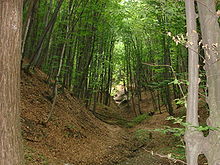| This article does not cite any sources. Please help improve this article by adding citations to reliable sources. Unsourced material may be challenged and removed. Find sources: "Codru" forest – news · newspapers · books · scholar · JSTOR (December 2009) (Learn how and when to remove this message) |

Codru (plural form: codri; English: forests or woods) is the name of the forests that grow in the hilly part of central Moldova. While the Moldovans today speak a Romance language, the name "codru" is likely of pre-Roman origin, and possibly derived from the indigenous Paleo-Balkan languages such as Thraco-Illyrian (which includes Daco-Thracian), spoken by the pre-Roman and pre-Hellenic people of the region. The word for hill is "kodra" (the plural rolling hills or small hills are "kodrina") in Albanian, which is the sole survivor of Thraco-Illyrian.
History
During the Middle Ages most of the Principality of Moldavia's hills were forested, and the forested area in general was referred to as codrii, with bigger regional forests often given names such as Codrii Cosminului (Cosmin Codrii), Codrii Plonini (Plonini Codrii), Codrii Hotinului (Hotin Codrii; also, Pădurea Hotinului, Hotin Forest), Codrii Orheiului (Orhei Codrii), Codrii Lăpușnei (Lăpușna Codrii).
Although the rolling hills represent about 80%–90% of the territory of Moldova, the forested area has decreased after 1800 due to intensive agriculture of the fertile land to about 12%. At the moment the area of the forest is continuously decreasing, both in surface and ecologically. In early 21st century the area is estimated under 35%. Despite the fact that there are still several big forests that have been preserved, including some designated as national parks, the country currently suffers from acute insufficiency of forests (with respect to its normal ecology), translated into poorer and less water for human and irrigation use.
These uplands are interlaced by deep, flat valleys, ravines, and landslide-scoured depressions separated by sharp ridges. Steep, forest-clad slopes account for much of the codrii.
The highest point in Moldova, Bălănești Hill (Dealul Bălănești; 429 m or 1,407 ft) is located in the Cornești Hills, located between Prut and Răut rivers, in the core codrii area.
See also
References
External links
47°06′00″N 28°18′00″E / 47.1000°N 28.3000°E / 47.1000; 28.3000
Categories: